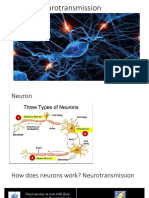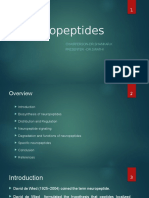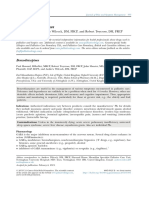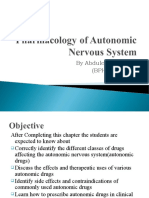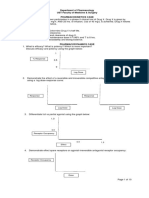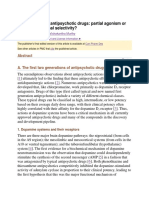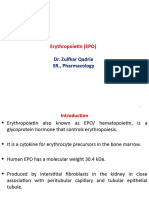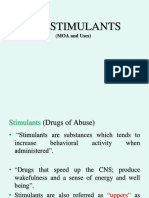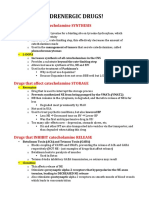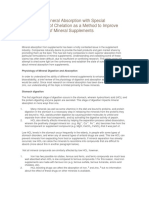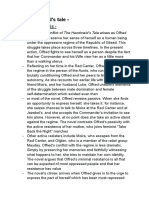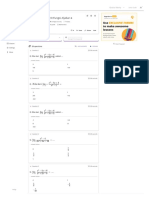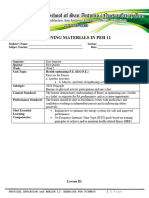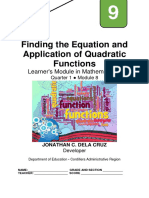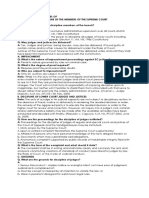ION CHANNELS: GABA RECEPTOR
I. Receptor Name and Classification
The GABA receptor is a ligand gated ion channel that is selectively
permeable to chloride ions. The neurotransmitter receptor opens when an
agonist binds to the protein channel.
II. Examples of receptors or Organs of distribution
The two types of GABA receptors are GABAA and GABAB. These are
both structurally different as GABAA is a ligand-gated ion channel, while
GABAB is a G-protein coupled receptor. Both of which are found within the
central nervous system. Specifically, GABAA is found in the postsynaptic
neuron mediating fast post-synaptic inhibition.
III. Receptor structure and receptor sites
GABA A GABA B
GABAA is composed of a protein pentamer containing 2 𝛂, 2 𝛃, 1 𝛄 subunits in
a 𝛂-𝛃-𝛂-𝛃-𝛄 sequence. Variations in 𝛂 and 𝛄 subunits account for different
sensitivity and responses to different drugs. This could also be used in
designing new drugs that are very selective in targeting a particular subunit,
and at the same time giving very few side effects. The endogenous ligand,
GABA, binds to the 𝛂/𝛃 interface. The receptor also contains different
allosteric sites for drug antagonists and agonists in the 𝛂/𝛄 interface and on
the 𝛂 and 𝛃subunits.
GABAB is a G-coupled protein consisting of two different seven
transmembrane subunits B1 and B2. This kind of GABA receptor is located
pre and post synaptically. GABA binds to the extracellular domain of B1, while
B2 interacts and activates the G-protein
IV. Endogenous ligands
Gamma amino butyric acid (GABA) is the main inhibitory transmitter in
the brain. They are abundant in the nigrostatial system, but also present in the
1
� grey matter. GABA is synthesized in pre-synaptic neurons, through the
conversion of glutamate to GABA by glutamic acid decarboxylase.
GABA is stored in vesicles within pre-synaptic neurons. It is released
when an action potential reaches the presynaptic terminal causes the fusion of
the synaptic vesicle to the plasma membrane. This will cause a depolarization
in the membrane, allowing for the influx of Ca2+ ions and the release of GABA
through exocytosis. GABA is released into the synaptic cleft and would then
bind to 𝛂/𝛃 interfaceon GABAA on the post synaptic neuron. Since not all of the
GABA released will bind to the receptor, GABA is quickly removed by
degradation (enzyme) or recycled by another nerve or glial cell through
sodium ion symporter channels. This allows for the precision and accuracy in
synapse signaling.
V. Process of signal transduction
When GABA binds to the 𝛂/𝛃 interface, it would induce a
conformational change that would allow the passage of chloride ion through
the channel opening. Influx of the chlorine ions results in the increases of the
membrane potential, near that of the resting potential -70 mV, which in turn
causes hyperpolarization. This moves the postsynaptic potential away from
the threshold potential, preventing the generation of action potential.
VI. Examples of physiological functions
GABAA is responsible for inhibitory post synaptic potential (IPSP) which
results in the absence of nerve impulse in the neurons. It counteracts the
excitatory neurotransmitter glutamate. Anxiety disorders, panic attacks,
seizures, addiction, headaches, Parkinson’s syndrome and cognitive
impairment are attributed to the loss of GABA. Diseases associated with
GABAergenic neurotransmission include epilepsy, insomnia, and
schizophrenia. GABA A receptors also play a role in sleep and in mediating
dopamine levels.
The functions of GABAB receptor include the inhibition Ca2+ voltage channels
which then reduce transmitter release, the opening K+ channels, reducing post
synaptic excitability and the inhibition of adenylyl cyclase thus decreasing
cAMP.
VII. Pharmacological applications
Modulatory Site Modulatory site
Receptor Site
(BZ) (Others)
Neurosteroids
Endogenous
GABA - (progesterone
Ligand
metabolites)
Barbiturates
Other agonists Muscimol Benzodiazepines Steroid
anaesthetics
Bicuculline
Antagonists Flumazenil -
Gabazine
Channel Blockers Picrotoxin - -
2
� Drug/Ligand Structure
GABA
• Main inhibitory neurotransmitter in the body
Muscimol
• It is derived from hallucigenicmushroom and
resembles chemical effect of GABA.
Benzodiazepene
• An agonist and positive allosteric modulator of the
GABAA receptor as it noncompetitively binds to its
own modulatory site (BZD) at the 𝛂/𝛄 interface. Its
mechanism of action is to increase the frequency of
the channel opening, allowing for the more chloride
ions to pass through.
Barbiturates
• It is also a non competitive agonist and positive
allosteric modulator of the GABAA receptor as it
binds to the 𝛂 and 𝛃subunits.Its mechanism of
action is to increase the time of the ion a channel
opening. The drug lengthens the duration of the
response of the receptor.
Flumazenil
• Flumazenil is a derivative of 1,4-benzodiazepine
and it has a high affinity for the benzodiazepine
binding site, acting as a competitive antagonist.
This drug is used in the depressant effects of
benzodiazepine overdose.
Picrotoxin
• It is a channel blocker of the GABAA receptor as it
decreases the mean channel open time to 1
millisecond. This drug induces convulsions.
Bicuculline
• This drug is an antagonist and a competitive
inhibitor of the receptor. It also induces convulsions.
The general clinical uses of GABA receptor drugs include relief of
anxiety and insomnia, for sedation and amnesia before and during medical
and surgical procedures, treatment of epilepsy and seizures, muscle
relaxation, and psychiatric diagnostic aid for treatment.
VIII. Answers to the exercises
3
� a. Explain the physiological
consequences of increases in
Chloride ion conductance.
Review hyperpolarization and
threshold potential.
The increase in chloride ion
conductance causes the
membrane potential to become
more negative, thus causing
hyperpolarization. At this state,
the potential is too negative and
nearly matches the resting
potential of the cell. Therefore, it cannot reach the critical level called the
threshold potential that is needed for an action potential/nerve impulse to
take place since an action potential an “all or nothing” event that should
come from depolarization (more positive cell membrane potential).
b. Draw and describe the mechanism of action of the drug diazepam using
the GABA receptor model.
Diazepam is a kind of benzodiazepine and it is a positive allosteric
modulator of the GABA A receptor as it binds to the 𝛂/𝛄 interface. Its
mechanism of action is to increase the frequency of the opening of the ion
channel allowing for more more chloride ions to pass through the
membrane.
IX. Answers to additional panel questions
a. Explain the difference of allosteric modulation and partial agonists.
4
�In allosteric modulation, drugs bind to the same receptor molecule but at different
sites than that of the agonist and they do not prevent the binding of an agonist to its
receptor site. These drugs can either enhance or inhibit the action of the agonist.
Allosteric activators can act by increasing either the efficacy of the agonist or its
binding affinity. In the curve, the combination of the agonist (A) and the allosteric
activator (C) increases the efficacy/response as compared to that of the agonist
alone. In the case of benzodiazepines and barbiturates, they allow GABA to bind to
the receptor site as the bind noncompetitively, and in effect enhancing the activating
effect of GABA in the passage of chloride ions by increasing frequency and duration
of channel opening respectively.
On the other hand, partial agonists bind to the
same receptor site as that of the endogenous
ligand; however, they have a low intrinsic efficacy
as they produce less than 100% of the response
of a full agonist, no matter how high its
concentration is, even at full receptor occupancy.
This is because a partial agonist is not able to
stabilize the the active conformation of the
receptor (Ra) leaving a fraction of the Receptor-
drug complex (Ri-D) in its inactive form. If with a
full agonist, a partial antagonist can act as an
antagonist at higher concentrations as partial
agonist and full agonist compete for receptor site
occupancy. Partial agonist binding increases
while full agonist binding decreases.
5
�References:
Alberts, B., Bray, D., Hopkin, K., Johnson, A., Lewis, J., Raff, M., ... & Walter, P.
(2013). Essential cell biology. Garland Science.
Davies, M. (2003). The role of GABA (A) receptors in mediating the effects of alcohol
in the central nervous system. Journal of psychiatry & neuroscience: JPN, 28(4), 263.
Denver Naturopathic Clinic. (n.d.). GABA: Gamma-Amino Butyric Acid. Available at
http://www.denvernaturopathic.com/news/GABA.html.
Harvey, R. A., Clark, M. A., Finkel, R., Rey, J. A., & Whalen, K. (2012).Lippincott’s
illustrated reviews: Pharmacology (Vol. 526, pp. 530-541). Philadelphia: Wolters
Kluwer.
Katzung, B. G., Masters, S. B., & Trevor, A. J. (Eds.). (2004). Basic & clinical
pharmacology (Vol. 8). New York, NY, USA:: Lange Medical Books/McGraw-Hill.
Olsen, R. W., &DeLorey, T. M. (1999). GABA receptor physiology and pharmacology.
Rang, H. P., Ritter, J. M., Flower, R. J., & Henderson, G. (2014). Rang & Dale's
Pharmacology: With student consult online access. Elsevier Health Sciences.
Winsky‐Sommerer, R. (2009). Role of GABAA receptors in the physiology and
pharmacology of sleep. European Journal of Neuroscience, 29(9), 1779-1794.
